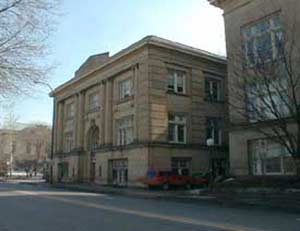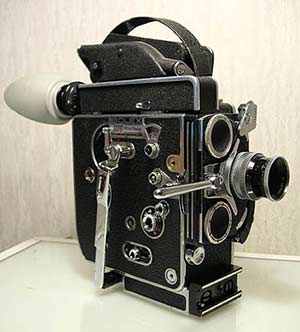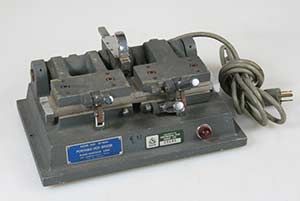Beginnings
In 1965 the University of Michigan’s Speech Department first introduced film classes to its curriculum. These new offerings included a seminar in motion picture history and a production class in 16mm filmmaking techniques.
Professor Robert E. “Bob” Davis was the first instructor. (Davis was among the earliest PhD recipients in media studies at the University of Iowa.) When he left U-M in 1969 to become chairman of the Department of Cinema and Photography at Southern Illinois University I was hired to replace him.
I have very fond memories of my students and these courses (Speech 423-Intro and, a few years later, Speech 523-Advanced Filmmaking). My nostalgia has to do in large part with the fact that the task of teaching student filmmaking at Michigan at that time was challenging. It was probably much like the situation that confronted filmmakers in post-revolutionary Russia–scant resources but a compelling urgency for exploring cinematic art.
A heartwarming innocence permeates my memories when I reflect on those formative years in the Frieze Building.
The equipment
Students who enrolled in my first class in the fall of 1969 had available to them a couple of 16mm Bell & Howell cameras and two 16mm Bolex cameras. Both had spring-driven motors that, respectively, would permit one to shoot for 38 and 28 seconds while filming at 24 frames per second. To continue filming, one had to rewind the motor with a large crank key on the side of the camera. Long-take cinematography was outside the realm of possibility.
The Bell & Howell and Bolex cameras were loaded with 100’ daylight loading spools which would provide 2-minutes-47 seconds of exposed images when shooting at 24fps. Each camera contained a three-lens turret that conveniently rotated for changes in shot scope.
These cameras are now considered a classic part of early filmmaking history, and both were widely used by WWII motion-picture journalists. The Bell & Howell was popularly known as the “crash” camera among war correspondents because it was practically indestructible. Thus, it served student filmmakers equally well.
The facility
The film “laboratory” in the Frieze Building (which also doubled as the editing room) had once been–I was told–the dressing room for the women’s basketball team when Frieze was Ann Arbor High School. A small defunct shower stall worked just fine as a darkroom for loading film.
Four editing stations sat along a shelf at the dressing room’s back wall. Each station came with a pair of 16mm rewinds, a Moviscop film viewer, an editing bin for hanging disassembled shots, and various film splicers–“cold” and “hot.” Students preferred the Maier-Hancock hot splicer because it contained a built-in electrical element that facilitated the drying of film cement.
Students liked to keep their basic editing tools in a discarded cigar box. A typical kit would include a yellow grease pencil for marking splice points, a small pair of scissors for breaking down the film to produce a rough cut, a bottle of film cement, a single edge razor blade for removing tricky emulsion around sprocket holes, and lint-free cotton gloves. The gloves were essential in preventing the accumulation of finger-tip oil that was notorious for capturing dust and ruining images. Needless to say, the Frieze Building, already in an advanced stage of deterioration, was hardly a dust-free environment.
Teaching fundamentals
Students will remember that my introductory course was constructed around four progressive exercises, each focused on a different area of film convention:
- A one-location film that required the inclusion of matching shot compositions in a triple-take refilming of the initial master shot action, i.e., medium shots and close-ups;
- A screen-direction film that practiced the art of maintaining continuity as the action moved freely among different locations (often this exercise would turn into a “chase film” played out on Ann Arbor’s city streets);
- A film with both available (natural) and artificial (electrical) lighting arrangements. The goals of the exercise were to use lighting as a creative tool for ‘sculpting” screen characters, for bringing out dimension and architectural details in the settings, and for the creation of atmospheric mood;
- An experimental film exercise that broke from current convention and displayed abstract and non-narrative cinematic techniques and structures. You know the fundamentals, now move beyond them.
The production process
Students executed each exercise in four-person teams with rotating roles: writer/director; cinematographer; producer; and continuity supervisor. Each writer/director also edited that particular film exercise. Students’ classmates, roommates, friends, or fellow fraternity/sorority members often populated each cast. In the final phases of the term each team developed a narrative, documentary, or experimental film for screening at a term-end “festival.” Soundtracks for that final project were “wild,” meaning they were recorded on and played back on 1/4-inch tape recorders.
Mishaps
Sometimes an unwitting filmmaker reloaded an exposed (but unmarked) film spool into the camera with an end result being two perfectly realized sets of images when projected–one upright, one upside down. We presented edited films in their original glue-spliced edits—there was no money for laboratory printing–and too often a film would break apart during the screening, eliciting sympathetic groans from understanding students.
Memorable projects
As I recall the young filmmakers gave it their all, soldiering on in spite of limited equipment and laboratory facilities. Even while working with scant resources and without the benefit of long-take or sync-sound capabilities, the teams still turned in memorable, engaging film work.
Two final projects from that first introductory filmmaking class of 1969 were especially memorable for different reasons.
Those Who Can’t was a 12-minute tongue-in-cheek docudrama produced in a team headed by future Hollywood screenwriter/director Lawrence Kasdan. The film featured U-M English professor, John Rodenback, who was one of Kasdan’s favorite instructors. Rodenback provided an eloquent voice-over, wryly commenting on his interaction with students both in the classroom and in his Haven Hall office.In one key scene, a female student in a miniskirt perches by his desk and Rodenback lights her cigarette (yes, students could smoke at will back then) as he explains his attempts to breathe intellectual life into his students. Those Who Can’t was both poignant and rich in humorous innuendo—features that would appear later in Kasdan’s notable films Continental Divide (screenwriter) and Body Heat (screenwriter/director).
Idol Worship/Idle Worship is another film that has stayed with me all these years. It fell into the experimental style of actualite film called “direct cinema.” Direct cinema proponents, striving for veracity in their documentary work, sought to minimize the presence of the camera–favoring unmoving, wide-angle views of a scene over hand-held, verite-styled shots. The idea was to emphasize and discover the subject(s) in the immediate environment and to maintain an aesthetic distance between filmmaker and film viewer.
Idol Worship took that concept to the extreme as two members of the production team tracked the Rolling Stones during a monthlong U.S. tour in 1969. Positioned on distant balconies the students captured unauthorized footage of a speck-sized Mick Jagger, and when the spring-wound camera ran out of film mid-performance, Jagger suddenly disappeared like a character in a turn-of-the-century Georges Melies stop-action trick film.
In the end there was really little to edit except the heads and tails of 100’-rolls of extreme long-shot footage that came in at about 30 minutes. I had to admire Idol Worship and the team’s tenacity in capturing some counterculture history in the making. And to their credit they did so a full year ahead of the Maysles brothers/Charlotte Zwerin documentary Gimme Shelter (1970), a direct-cinema exercise that covered the final, disastrous leg of the Stones’ 1969 tour.
A counterculture moment
Other memories of that fascinating era also come to mind. One day in the early 1970s, I received a phone call at my office in Frieze from a campus security authority who informed me that some students had requested access to the University’s underground tunnels. He was suspicious. No, I assured the caller, they were not radical left-wing Weathermen looking for a site to unleash some clandestine mayhem. They were just film students seeking a location for their “sci-fi” picture.
Remembrance and progress
What I remember most about my two decades or so of teaching filmmaking at Frieze was the commitment of the students. They were dedicated, enthusiastic, clever, and, above all, anxious to prove themselves as aspiring artists. Untold dozens went on to successful careers as directors, writers, editors, cinematographers, special effects artists, producers, gaffers, and—equally gratifying for me—outstanding media and film instructors at colleges and universities across the country.
The elegant North Quad edifice sits in Frieze’s place today. It combines living, teaching, and office space for the School of Information, and the Departments of Communication Studies and Screen Arts and Cultures. Filmmaking is taught in the latter department where laboratory areas include professionally built studio sets; a large green-screen room with digital compositing capabilities; rooms teeming with portable film and video equipment; and television studios surrounded by state-of-the-art electronic control rooms.
North Quad is a far cry from the Frieze Building. And today’s Screen Arts and Cultures students have access to an outstanding teaching staff of 35-plus faculty members who provide instruction in production and scriptwriting practicums, along with a broad range of “studies classes”—with emphases in theory, history, national cinemas, technology, and media-and-society, among many others.
I am thrilled to share an emeritus office in North Quad, and am especially thrilled when students from a distant past stop in and I can show them just how far film and television education has come here at the University of Michigan.








Joe Misiewicz - 1964 PhD
I was one of those who ‘glued’ my sire to win an Oscar film in reverse and as it made it thru the projector captivating the audience it was found in small pieces on the floor when the lights were turned on. Prof Beaver was excellent along with Profs Porter, Willis, Colburn, Yablonky and the Frieze memories are part of my life.
Reply
Jim Beck - 1961
Although I didn’t take any of Prf. Beaver’s film studies courses, I have had a lifelong interest in photography and enjoyed the article. Other connections include attending high school at the Frieze Bldg. and working for Bell & Howell as an engineering manager beginning in 1969.
Reply
Raymond Coveney - 1971 PhD geology
Being a close friend, neighbor, and fellow student (but in geology) I got to see Those Who Can’t back in the 60s. Thanks for jogging my memory about one of the finest short films ever.
Reply
Tim Artist - 1979 & 1982
Memories!
Reply
Carol Anderson-Reinhardt - 1994
I have many fond memories of my days in the Communications program and at the Frieze building. The transition to the digital era was just getting underway during my time at Michigan. What I learned is still relevant to my work today–great storytelling, style, and production fundamentals, all informed by an appreciation of filmmaking history. I just started a series of corporate “whiteboard” videos à la Khan Academy–complete with a Flash and on-camera video intro and tablet instruction, produced at very low cost on my Dell laptop.
You’re still one of my all-time favorites, Frank Beaver. “Time passes, values endure.”
Reply
clark cumings johnson - 1963
It would be great to hear a little more about Dr. Hugh Z. Norton who laid the foundations for much of what happened during and after his tenure at Michigan. The classes I had with him [Theater] were among the most profound, thought provoking and enriching I have ever experienced in my life, and I have a lot of classroom time.
Clark Cumings Johnson, J.D., PhD., LLD.
Reply
Irwin Starr
Filmmaking, perhaps better called remedial film making, was in fact being taught in the newly renovated Frieze Building in the early 60s.
The class was much more limited though likely utilizing the same Bolex, Bell & Howell, hot splicers and film bins described.
The budget was ample for only one exercise, for every two students. My “lab partner” Dick Lutz and I struggled over little piece called Printers Dream. The film is long gone, but the opening we created for it still haunts a closet in my home office. It was patiently created with the Bolex, tripoded on the floor of my attic apartment on North State Street. We spent all night animating the title by moving cut out letters on a white card frame by frame. Finishing in the early hours of the morning we suddenly looked at each other, the realization hitting us simultaneously, the camera was upside down. As I remember we scronged our own dollars to pay for printing the title in reverse so we could use our highly unpolished animation.
Both of us actually ended up in the television industry, managing others who had more highly developed film skills than ours.
The memories, like most from the Ann Arbor days, are grand.
Reply
Caren Deming - BA, 1965, PhD, 1975
Thanks for the memories of those familiar tools. I still have several cans of film, though I dare say none has run through a projector since that fateful class screening.
Reply
Lori Jackson - 1981
I LOVED any of my courses with Professor Frank Beaver! I took cinematography and filmmaking and several other courses. For a filmmaking course I convinced several sorority sisters and a starting football player to be in my film. I produced the film, edited the film with the hot splicing machine and then added background music. The whole process had to be hush hush because “Bo” wouldn’t have wanted one of his starting players to be wearing roller skates while on a full scholarship for football. When I completed the film it was shown on the big screen at Michigan…….neat to see your work on the big screen. Excellent course!
I live in San Diego now and will be traveling back with my son who will be starting his senior year in engineering. As we drive by North Quad I will remember my years of meaningful courses at the Frieze Building!
Reply
David Saling - 1984
I was a film/video major when Robert Altman came to shoot his film Secret Honor in Ann Arbor. The actor also performed the stage version of his one man show while he was there. Being a broke college student, I went to Professor Beaver’s office to ask if film students could see the show for free. Prof. Beaver happened to be talking to Altman when I walked in. I started to leave but Prof. Beaver invited me to stay. I asked my question and he said unfortunately not. Robert Altman then offered to lend me the money. I said no thanks but probably should have taken it…
Great memories…
Reply